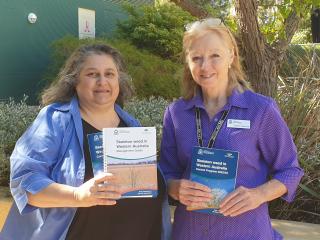Western Australia
January 19, 2023

DPIRD biosecurity officer Carla Tassone and administration officer Heather Staphorst, based at Narrogin, with the latest issue of the Skeleton Weed in Western Australia: Management Guide and Control Program publication, now available to landholders.
An updated guide to assist farmers to control skeleton weed infestations on their properties has been released by the Department of Primary Industries and Regional Development (DPIRD).
DPIRD program manager Martin Atwell said the changes ensured growers had the latest information to combat the serious weed, which can reduce crop yields by competing for moisture and nitrogen.
“This management guide aims to increase the capacity of landholders to manage and eradicate skeleton weed infestations on their properties and to prevent further spread within the State,” Mr Atwell said.
“It includes information on weed identification and reporting, known distribution maps, treatments for infested paddocks and compliance requirements.
“A key update includes new herbicide recommendations for control in crops and legume-based annuals during winter.
“It now includes a full list of trade names of products available for skeleton weed control and has an eradication treatment section for organic properties, plantations and urban properties.”
DPIRD, in conjunction with Local Action Groups, delivers the Skeleton Weed Program backed by the grower-funded Grains, Seeds and Hay Industry Funding Scheme.
“Without a coordinated program aimed at controlling spread, skeleton weed would now be much more abundant and widely established throughout the cereal growing areas,” Mr Atwell said.
“Our extensive annual surveillance program is underway and we encourage growers to regularly monitor their paddocks over summer, when plants are actively flowering and setting seed.”
Skeleton weed has upright and usually leafless stems, which gives the appearance of the skeleton of a plant.
It is most recognisable when flowering during summer and autumn, when it has distinctive bright yellow daisy flowers.
A copy of the ‘Skeleton Weed in Western Australia: Management Guide and Control Program’ is available from a local DPIRD office or Local Action Group, or email SkeletonWeedProgram@dpird.wa.gov.au.
Electronic copies and more skeleton weed information can be accessed here.
Any suspicious plants should be reported using the MyPestGuide Reporter app or to the department’s Pest and Disease Information Service on +61 (08) 9368 3080 or padis@dpird.wa.gov.au.